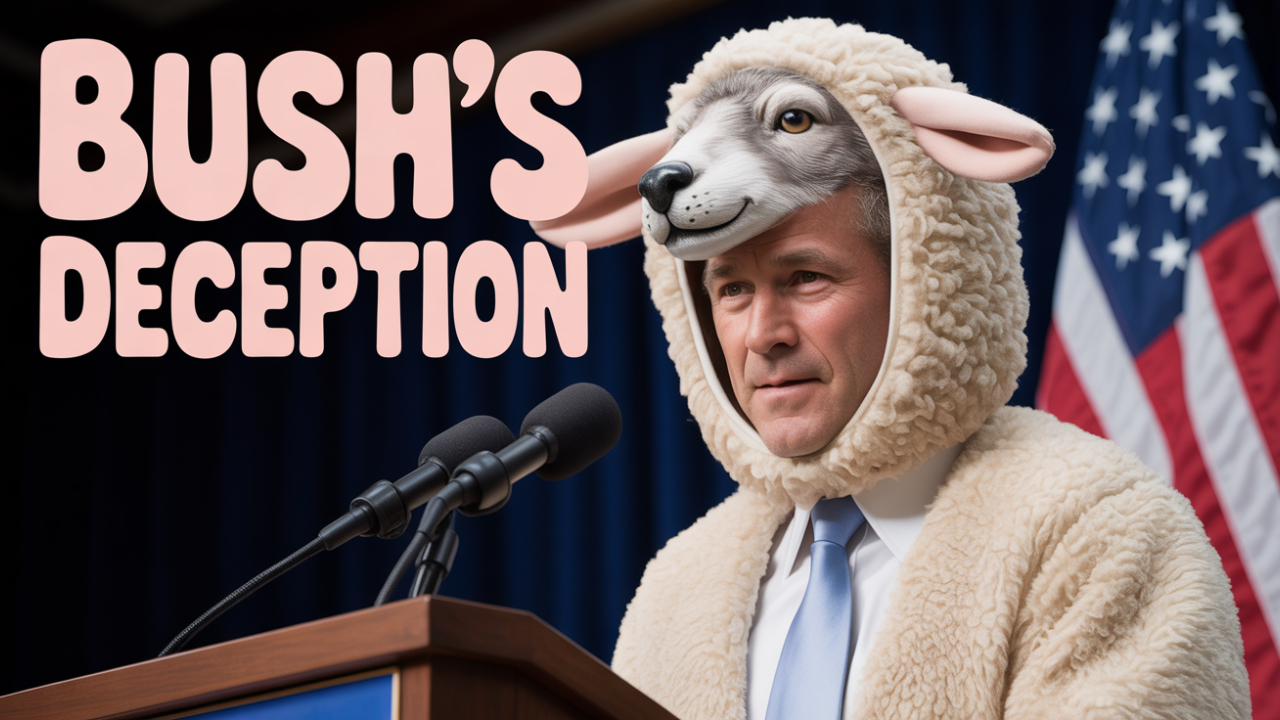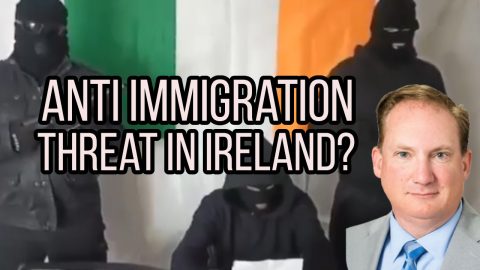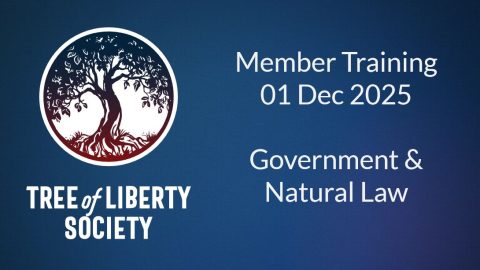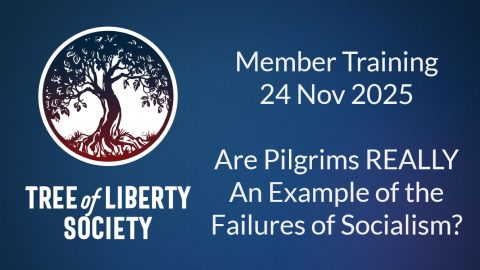Understand The Past To Understand The Present
This is the second installment in our series exposing wolves in sheep’s clothing in government. (Check out our first on Ronald Reagan here) In this edition, we examine the political career of George W. Bush. As we review these supposed “conservatives”, we will be better equipped to identify other wolves in sheep’s clothing as the come on the scene, without being blinded by false hope and misplaced emotion.
During his presidency—and even in the years following—many Republicans viewed Bush Jr. as a “good Christian.” Some even ran billboards asking, “Miss me yet?”—implying that he was preferable to his successor, who continued many of his policies.
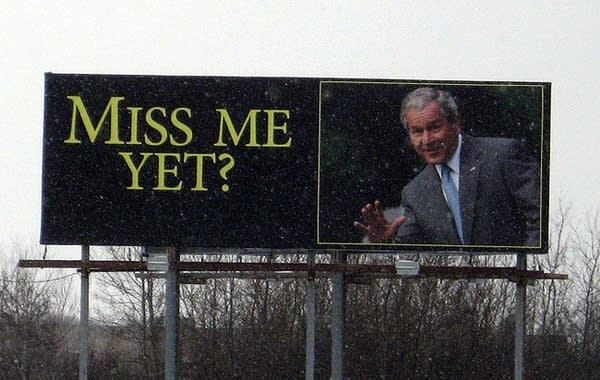
From the PATRIOT Act to endless wars, Constitutionalists warned others, while wolves in sheep’s clothing—such as Sean Hannity, Glenn Beck, and Mark Levin—accused anyone who opposed these policies of siding with “the terrorists.”
For decades, presidential elections in the United States have been framed as legitimate competitions between two major candidates. Voters have been repeatedly led to believe they are making a meaningful choice when casting their ballots for either a Democrat or a Republican.
Beyond their stylistic differences, the two major parties offer little real contrast. One promises rapid implementation of its agenda, while the other takes a more measured approach—yet both ultimately pursue the same objectives. Setting rhetoric aside, each has worked for years to advance the nation toward a New World Order. This long-standing initiative by The Insiders seeks to establish an all-powerful United Nations with total control over a weakened United States while imposing expansive government-driven social programs on the American people.
Recognition of this objective and the illusion of political rivalry occasionally comes to light, as it did in 1966 with the publication of revelations by Georgetown University Professor Carroll Quigley. In Tragedy and Hope: A History of the World in Our Time, Quigley exposed an elite “secret society” 1 intent on global control. He even identified the Council on Foreign Relations as the visible U.S. branch of what he called “this network” 2 —a group we now refer to as The Insiders.
Notably, Quigley concisely captured a concealed reality about American politics. With a rare moment of unfiltered honesty in an increasingly politically correct world, he wrote:
“The argument that the two parties should represent opposed ideals and policies, one, perhaps, of the Right and the other of the Left, is a foolish idea acceptable only to doctrinaire and academic thinkers. Instead, the two parties should be almost identical, so that the American people can “throw the rascals out” at any election without leading to any profound or extensive shifts in policy.”3
Building on that passage from his extensive 1,348-page work, the man whom Bill Clinton acknowledged as his mentor highlighted “policies that are vital and necessary for America—no longer subjects of significant disagreement, but merely debated in terms of procedure, priority, or method.”4 Quigley explained that these shared policies serve to ensure that the United States will:
“… continue to function as a great world Power in cooperation with other Powers, avoid high-level war, keep the economy moving without significant slump, help other countries do the same, provide the basic social necessities for all our citizens ….”5
From Quigley’s general observations, it becomes clear that he anticipated both major parties would:
(1) keep the United States under the influence of the UN,
(2) engage only in undeclared wars,
(3) maintain government control over the nation’s economy,
(4) continue foreign aid programs for other countries, and
(5) endorse socialist paternalism for the American people.
According to Quigley, these objectives were “no longer subjects of significant disagreement.” Unfortunately for the nation, his assessment—made in 1966—proved accurate. He acknowledged that while disagreements could exist, they would be limited to “details of procedure, priority, or method.” While Quigley and the Insiders he described may have supported this direction, such policies ultimately threaten the nation’s independence and erode the freedoms of the American people.
America is under siege, and the attack comes from within. Unless a counterattack is successfully undertaken, a certain slide into tyranny stares America in the face.
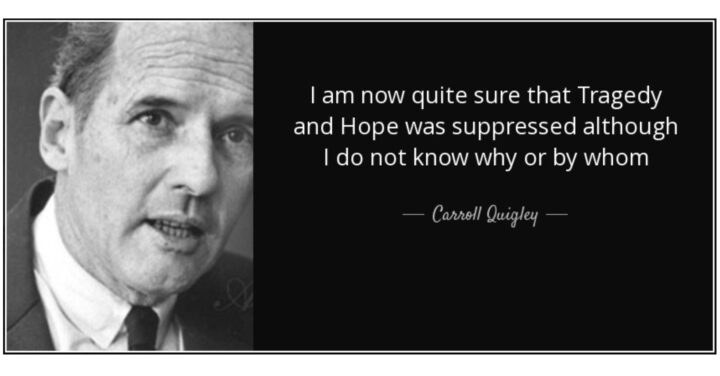
Insiders Select Their Candidates
George W. Bush’s presidency will undoubtedly be defined by his response to the September 11, 2001 attacks and the subsequent 2003 war in Iraq. However, to fully grasp his legacy, it’s essential to examine the path that led to his selection as the Republican candidate. The nomination process—only slightly different from Al Gore’s selection by the Democrats—was a textbook example of Insider-driven strategy.
If Carroll Quigley’s portrayal of political influence is accurate, as we believe it to be, then both the Republican and Democratic Parties were expected to nominate candidates committed to advancing the Insiders’ agenda. Securing such individuals is not an overnight endeavor—but they are always found.
The Insiders’ process for selecting a dependable standard-bearer likely begins with vetting potential candidates for their ability and willingness to adhere to the Insider agenda. A select few are then positioned within Insider circles, while mass media—controlled by other Insiders—announces the appointment of advisers to guide certain “front-runners” in their bid for nomination.
In reality, these early favorites are likely informed of exactly who their advisers will be. Once elected, the winner proceeds to install these same handlers into key government positions. As we will demonstrate, this is precisely what George W. Bush did upon officially securing victory in the historically tight 2000 election. Had Al Gore won instead, he too would have undoubtedly staffed his administration with the Insiders who had shaped his campaign.
In April 1998—two and a half years before the 2000 presidential election—former Secretary of State George P. Shultz convened the first meeting of what would become a “brain trust” designed to prepare George W. Bush for the presidency. Among those involved in shaping Bush’s political and strategic outlook were Richard Cheney, Condoleezza Rice, Richard Perle, Robert Zoellick, and Paul Wolfowitz.6 With the exception of Shultz, all were members of the Council on Foreign Relations (CFR) and later held influential positions within the Bush administration. Shultz, who had been a CFR member from 1974 to 1982, remained outside the administration, continuing his work as a fellow at Stanford University’s Hoover Institution.
Shultz’s leadership in this group is notable. A key Insider for decades, he was a member of the Council on Foreign Relations (CFR) from 1974 to 1982 and served on its board of directors from 1980 to 1982. His political influence spanned both Republican and Democratic administrations, holding positions under Eisenhower, Kennedy, Nixon, and Reagan—all of which were heavily populated with CFR members.
Starting in 1974, Shultz spent eight years as a top executive at San Francisco’s Insider-connected Bechtel Corporation. In 1982, he returned to government as President Reagan’s Secretary of State, where he maintained a consistent record of advancing internationalist policies and appeasing communist regimes.7
Following the brain trust’s inaugural meeting at the Shultz residence, further discussions with Governor Bush took place in Austin, Texas. These sessions were later supplemented through teleconferencing, fax correspondence, and electronic messaging.8
Mr. Bush clearly excelled in this Insider-driven political grooming, as he quickly became the overwhelming favorite for the 2000 Republican presidential nomination.
In the year leading up to the election, further evidence emerged that Insiders had consolidated their influence over both major party nominees. This became particularly clear when each candidate publicly revealed his list of foreign policy advisers. Of the 15 individuals selected by Bush in December 1999, all but one were either current or recent members of the Council on Foreign Relations (CFR).
According to reports from the New York Times and other media outlets, Bush’s CFR-affiliated advisers included George Shultz, Richard Cheney, Robert Zoellick, Paul Wolfowitz, Richard Perle, Condoleezza Rice, Henry Kissinger, Newt Gingrich, Donald Rumsfeld, Martin Feldstein, Robert Blackwell, Stephen Hadley, Robert Kimmitt, and Dov Zakheim.9
Having long been a favored figure among Insiders, Democrat Al Gore required less political grooming. Nonetheless, he adhered to the Insider-established precedent by appointing 11 members of the Council on Foreign Relations (CFR) to his foreign policy team in May 2000.
His selected CFR-affiliated advisers included Joseph Lieberman, Richard C. Holbrooke, Richard N. Gardner, Mel Levine, Joan E. Spero, Robert E. Hunter, Laura D. Tyson, Ashton B. Carter, Graham T. Allison, Marc Ginsburg, and Samuel R. Berger.10
Although neither Bush nor Gore was a Council on Foreign Relations (CFR) member, both ultimately selected running mates with CFR credentials. Richard Cheney joined the Republican ticket, while Senator Joseph Lieberman (D-Conn.) secured the Democratic nomination for vice president.
This ensured that regardless of the outcome on Election Day, the Insiders’ influence over policy would remain intact. As CFR member James M. Lindsay noted in the September/October 2000 issue of Foreign Affairs, “Both Al Gore and George Bush are internationalists by inclination.”11 According to Quigley’s analysis, voters were essentially presented with a choice between Insider Candidate A or Insider Candidate B, while outsider candidates were either marginalized or openly discredited by media outlets influenced by the Council on Foreign Relations (CFR).
Following the historically tight 2000 election, George W. Bush, upon securing the presidency, appointed key figures from his Insider brain trust to the most powerful positions within his administration.
Bush Toes the Insider Line
George W. Bush’s only direct Insider affiliation was his membership in Yale University’s secretive Skull & Bones Society, a connection likely inherited from his father. After graduating from Yale in 1968, he spent several years in the Texas Air National Guard, earned an MBA from Harvard University, and returned to Texas in 1975 to pursue a career in the volatile oil industry.
In 1978, he made his first attempt at elected office, narrowly winning the Republican primary for a U.S. House seat, only to suffer a decisive defeat against his Democratic opponent in the general election.

Throughout his career, George W. Bush’s most influential asset has been his family name, which gained even greater prominence when his father ascended to the roles of Vice President and later President. As the son of a well-connected Insider (see Part III of this book), Bush was able to secure multiple corporate positions, eventually leading to his ownership of the Texas Rangers Baseball Club. In 1994, he was elected Governor of Texas.
By early 1998, the Texas Republican convention put forward an emphatically anti-Insider platform, advocating for the abolition of the EPA, ATF, and three federal departments: Housing and Urban Development, Health and Human Services, and Education. Supported overwhelmingly by the 7,500 convention delegates, the platform also proposed replacing the Federal Reserve with a gold standard, withdrawing the United States from the United Nations, repealing NAFTA and GATT, and ending U.S. contributions to the International Monetary Fund (IMF). Additionally, it called on Congress to conduct a thorough investigation into the Council on Foreign Relations (CFR) and the Trilateral Commission.12
As a Republican governor seeking reelection, Bush was visibly unsettled by the convention’s platform. Already under the guidance of the brain trust, he quickly distanced himself from its proposals, declaring that he would not endorse the platform. He insisted it was merely “a statement of the delegates of the convention” and did not reflect the official stance of any candidate. The Houston Chronicle characterized his approach by stating that Bush “runs on his own agenda.”13 Bush’s agenda diverged significantly from the priorities outlined by Texas Republicans. Supporting any of their demands would have jeopardized his standing with his new mentors. However, his refusal to endorse the Texas Republican platform did not come at a political cost. When he secured reelection as governor in 1998, his prominence among Insiders only grew.
Richard Cheney: An Insider’s Insider
While George Shultz played a key role in the early selection and political grooming of George W. Bush, Dick Cheney soon emerged as his primary mentor. According to a feature article in USA TODAY on July 28, 2002, Cheney was described as “clearly the dominant voice in shaping foreign policy.”14 The article further noted that Cheney and his aides played a central role in shaping the administration’s strategy in the war on terrorism and its policy stance on Iraq. A January 31, 2003, New York Times piece described the “powerful bond” between Cheney and President Bush, stating that Cheney’s influence had significantly grown. The authors quoted Congressman Rob Portman (R-Ohio), who remarked, “You feel when you’ve talked to the vice president, you’ve talked to the president.”15
Cheney openly affirmed his unwavering dedication to the Insider agenda—as well as his strategic avoidance of certain affiliations—during a speech to the Council on Foreign Relations (CFR) at the Ritz-Carlton Hotel in Washington, D.C., on February 15, 2002. Addressing the assembled Insiders, he remarked, “It’s good to be back at the Council on Foreign Relations. I’ve been a member for a long time and was actually a director for some period of time.” He then added with notable candor, “I never mentioned that when I was campaigning back home in Wyoming.”16
Cheney misled Wyoming’s voters, who remained largely unaware of his deeper political affiliations while he represented them in Congress. His revealing remarks—self-indicting yet met with approving laughter from Insider circles—were broadcast during the event, which prominently featured David Rockefeller, a leading figure among the Insiders.
Cheney’s long tenure as an Insider began in the early 1970s when Donald Rumsfeld, then a member of the Council on Foreign Relations (CFR), selected him for several positions within Richard Nixon’s second administration (1973–1974). Under President Gerald Ford, Cheney served as Deputy Chief of Staff to Rumsfeld and, upon Rumsfeld’s appointment as Secretary of Defense, Cheney—at just 34 years old—assumed the role of White House Chief of Staff.
Following Ford’s defeat in 1976, Cheney returned to Wyoming and was elected as the state’s sole U.S. House Representative, serving five terms (1979–1989) while publicly presenting himself as a committed conservative. However, unbeknownst to most of Wyoming’s citizens, Cheney joined the CFR in 1982 and later served two separate terms on its board of directors (1987–1989 and 1993–1995). His congressional career ended when George H.W. Bush appointed him Secretary of Defense in 1989, a position he held until 1993, after which he transitioned to a role at Washington’s American Enterprise Institute.
In 1995, Cheney became CEO of Halliburton Company, a Texas-based energy industry supplier. Writing for The New Republic in 2000, Lawrence F. Kaplan quoted a Halliburton executive stating, “Dick gives us a level of access that I doubt anyone else in the oil sector can duplicate.” Cheney leveraged his influence to secure a $490 million taxpayer-funded Export-Import Bank loan guarantee for Russia’s Tyumen Oil Company, which then purchased $300 million worth of equipment from Halliburton. Kaplan further noted that Cheney’s political clout surpassed even that of Secretary of State Madeleine Albright and Texas Governor George W. Bush, both of whom had unsuccessfully attempted to block the loan.17 One can only imagine the national uproar had anyone other then a well-connected Insider arranged such a deal.
Following Desert Storm—the first U.S. war with Iraq—Cheney, serving as Secretary of Defense under George H.W. Bush, tasked Paul Wolfowitz with drafting a long-term strategy for Iraq. Wolfowitz developed a plan aimed at removing Saddam Hussein from power. Though both men lost their positions when the Clinton administration took office in 1993, their ambitions remained unchanged.

By 1997, they established the Project for the New American Century (PNAC) and sent a letter to President Clinton, urging military action to oust Hussein. PNAC’s key members—including Dick Cheney, Paul Wolfowitz, Donald Rumsfeld, Richard Perle, and Lewis Libby (Cheney’s former top aide)—all held Council on Foreign Relations (CFR) credentials. Upon George W. Bush’s presidency, these figures assumed leading roles in his administration and became the chief architects of the 2003 Iraq War.18
As the search for a running mate approached in the months leading up to the 2000 Republican convention, George W. Bush tasked Dick Cheney with leading the selection committee. Cheney, a key member of Bush’s brain trust, purportedly conducted a thorough review of potential candidates—ultimately recommending himself. Bush swiftly approved, and the Republican convention formally nominated the pair.
Upon securing victory in the 2000 election, the Bush-Cheney administration was populated with Council on Foreign Relations (CFR) stalwarts, many of whom had been involved in Bush’s early political preparation. Key appointments included:
– Condoleezza Rice as National Security Adviser
– Donald Rumsfeld as Secretary of Defense
– Paul Wolfowitz as Deputy Secretary of Defense
– Robert Zoellick as U.S. Trade Representative
– Colin Powell as Secretary of State
– Paula A. Dobriansky as Under Secretary of State for Global Affairs
– George Tenet as CIA Director (continuing from his prior tenure)
– Elaine Chao as Secretary of Labor
– And many others from the New York-based center of Insider influence.
By late 2002, with economic troubles mounting, Bush dismissed Treasury Secretary Paul O’Neill, a longtime Cheney associate from the Ford administration. He replaced O’Neill with John W. Snow, another Cheney ally from the same era. Snow’s appointment was met with approval from CFR Chairman Peter G. Peterson, who had longstanding ties to Snow through his Concord Coalition, a policy organization established in 1992.
Early Insider Planning
Efforts to integrate America into a sovereignty-eroding world government predate the administrations examined in this book. During the Wilson administration (1913–1921), an earlier generation of Insiders sought to achieve this objective by bringing the United States under the authority of the League of Nations.
Key proponents of the 1919 attempt to subordinate America to the League included influential figures who would go on to establish the Council on Foreign Relations (CFR)—among them Edward Mandell House, John Foster Dulles, Allen Dulles, Sumner Welles, and Walter Lippmann. Founded in 1921, the CFR wasted little time in revealing its overarching vision, publishing Philip Kerr’s endorsement of “world government” in the inaugural September 1922 issue of Foreign Affairs, its flagship journal.19
Backed by funding from Rockefeller and Carnegie Foundation Insiders, the Council on Foreign Relations (CFR) steadily expanded its influence, embedding its members within the Franklin Roosevelt administration (1933–1945). Over the following decades, regardless of whether the White House was occupied by a Democrat or Republican, the CFR-led efforts to erode U.S. sovereignty persisted. In each administration, hundreds of top officials were either active CFR members or cooperative allies advancing its agenda.
In 1961, under the leadership of Secretary of State Dean Rusk (a CFR member), the State Department developed the policy document Freedom From War: The United States Program for General and Complete Disarmament in a Peaceful World. President John F. Kennedy formally presented this plan to the United Nations on September 25, 1961. It was immediately embraced as official U.S. policy, outlining a sequence of measures—many of which have since been implemented—culminating in the transfer of all national military forces, including those of the United States, to the United Nations.20 The UN would then possess the world’s only military force.
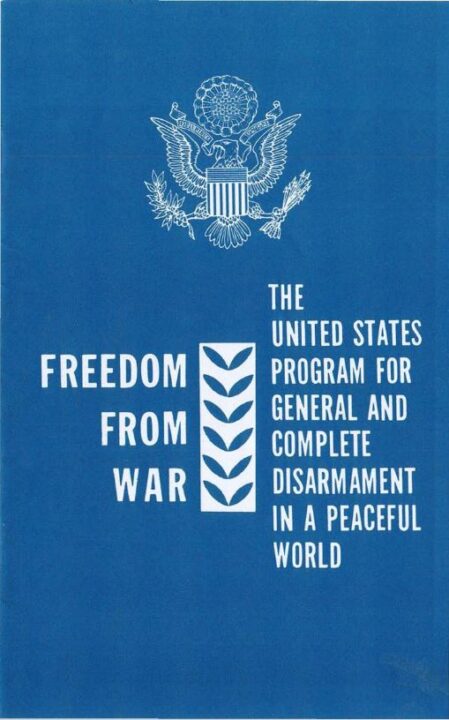
In 1962, the State Department commissioned Professor Lincoln P. Bloomfield (a CFR member) to develop a strategic proposal, which was later published as A World Effectively Controlled by the United Nations. This document not only advocated for civilian disarmament but also emphasized the necessity for nations to relinquish control over their military forces, transferring authority to the United Nations.
Bloomfield’s report explicitly asserted, “The overwhelming central fact would still be the loss of control of their military power by individual nations. If this becomes achievable, the details will not be insurmountable.”21
The UN Authorizes; America Fights
The objectives outlined in these plans continue to take shape, driven in part by precedents set during earlier conflicts. The Korean War marked a significant turning point, as U.S. forces were deployed under United Nations authorization without the constitutionally mandated declaration of war by Congress. A similar pattern emerged in Vietnam, where military action proceeded without congressional approval, instead relying on authorization from the Southeast Asia Treaty Organization (SEATO)—a UN-affiliated entity established under Article 51 of the UN Charter. Both of these UN-sanctioned wars extracted a heavy toll in American lives and sovereignty.
Like SEATO, NATO was founded under Article 51 of the UN Charter. When the alliance was established in 1949, Americans were told its primary purpose was to counter the potential expansion of Soviet influence in Western Europe. However, NATO’s broader function extended beyond this claim. Secretary of State Dean Acheson (a CFR member), a leading advocate for NATO, clarified its underlying purpose in a March 19, 1949 speech urging Senate ratification:
“It is designed to fit precisely into the framework of the United Nations… it is an essential measure for strengthening the United Nations.”22
Article 1 of the NATO Charter mandates that member nations must “refrain from the threat or use of force in their international relations in any manner inconsistent with the purposes of the United Nations.” 23 In its 14 brief articles, the NATO Charter mentions the United Nations five times.
Americans have been told that NATO not only curbed the Soviet Union’s expansionist ambitions but also played a key role in the USSR’s eventual collapse. If these were truly NATO’s sole objectives, one might reasonably expect that the dissolution of the Soviet Union in the early 1990s would have prompted NATO’s own disbandment.
The Southeast Asia Treaty Organization (SEATO), founded in 1954 under UN authority,24 ceased operations in 1975 following the conclusion of the Vietnam War. However, NATO not only continued to exist—it expanded its influence, asserting political and economic control over its member states, consistent with the vision of its founders. In recent years, NATO has incorporated several former Soviet satellite states into its ranks. Its forces, now engaged in UN-sanctioned operations in Eastern Europe and Afghanistan, function as the military arm of the United Nations.
Were he alive today, Dean Acheson would no doubt take great satisfaction in the trajectory of his creation.
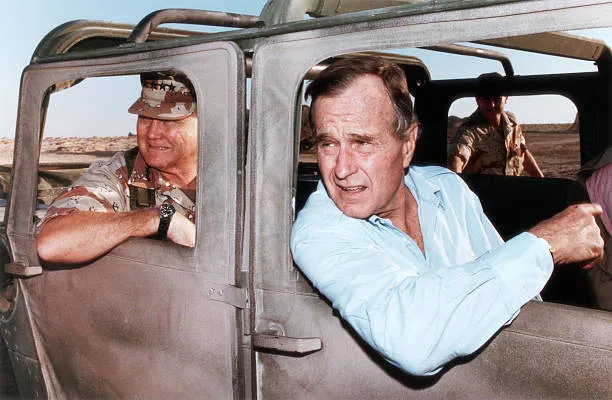
For the 1991 Gulf War, commonly known as Desert Storm, President George H.W. Bush followed precedent by seeking and securing United Nations authorization for military action against Iraq. He emphasized that a central objective of the conflict was to establish a “reinvigorated United Nations” as a foundation for a “new world order.”25 ears later, in the lead-up to the second Iraq war, President George W. Bush expressed his aspiration for the United Nations to “renew its purpose.”26 The senior Bush called for a “reinvigorated” United Nations, while his son advocated for its “renewal.” Both clearly sought to strengthen the UN’s role, potentially at the expense of U.S. sovereignty.
During his presidency, Bill Clinton (a CFR member) turned to NATO, a UN-aligned entity, for authorization to deploy troops to the former Yugoslavia. Similarly, following the September 11, 2001 terrorist attacks, George W. Bush sought and secured UN authorization to launch the war on terrorism.27
Although many believed the United States was acting independently in the second Iraq war, the Bush administration consistently affirmed the United Nations’ involvement. In a formal letter to the UN Security Council on March 20, 2003, U.S. Ambassador John Negroponte (a CFR member) cited Security Council resolutions 678 (1990), 687 (1991), and 1441 (2002) as providing official “authorization” for the invasion.28
Since World War II, every U.S. military conflict has been conducted under United Nations authorization. Additionally, American leaders have consistently committed U.S. armed forces to fulfill various UN-directed missions.
Like many administrations before them, President George W. Bush and his team of Insider strategists—including Dick Cheney, Donald Rumsfeld, Colin Powell, Condoleezza Rice, Paul Wolfowitz, General Richard Myers, and others—have repeatedly bypassed their constitutional oath by engaging U.S. military forces in conflicts authorized by the United Nations. The ongoing effort to shift control of America’s armed forces to international oversight continues to take shape.
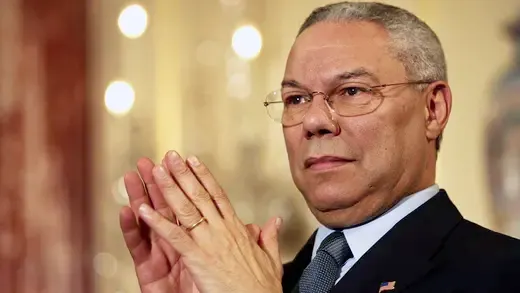
Powell Provides More of the Same
The presence of Council on Foreign Relations (CFR) members in government service expanded significantly over time. By the end of the George H.W. Bush administration, CFR membership in government stood at 387.29 This number grew to 548 by the conclusion of Bill Clinton’s presidency.30 At the midpoint of George W. Bush’s first term, the figure remained high at 516.30 Insider influence within the U.S. government shows no signs of diminishing.
Are Council on Foreign Relations (CFR) members reliable champions of Insider objectives? While not every CFR member is fully aware of the organization’s deeper agenda, Colin Powell’s confirmation hearing provides insight into its influence.
On January 17, 2001, during his Senate Foreign Relations Committee appearance seeking confirmation as Secretary of State, Powell voiced unwavering support for President-elect George W. Bush’s foreign policy vision, calling it “distinctly American internationalism.” Speaking on behalf of both himself and Bush, Powell affirmed, “We believe strongly in NATO,” and further emphasized, “I have seen what the UN can do over the years. It is a great organization. It is deserving of our support.”32
Secretary of State Colin Powell’s enthusiasm for the United Nations matched his unwavering support for NATO. This alignment was hardly surprising, considering that on his first day in office, he met with Council on Foreign Relations (CFR) President Leslie Gelb and seasoned CFR member Frank Carlucci.33
Within his first month as the nation’s top foreign policy official, Colin Powell traveled to New York to meet with UN Secretary-General Kofi Annan. Following their discussion, Powell addressed reporters, stating, “When it comes to our role as a member of the Security Council, we obviously are bound by UN resolutions and we’re not trying to modify that.”34 A Secretary of State who was not an Insider—or aligned with Insider interests—would never prioritize UN resolutions over the U.S. Constitution. Yet, instead of facing scrutiny, Powell was praised for his stance.
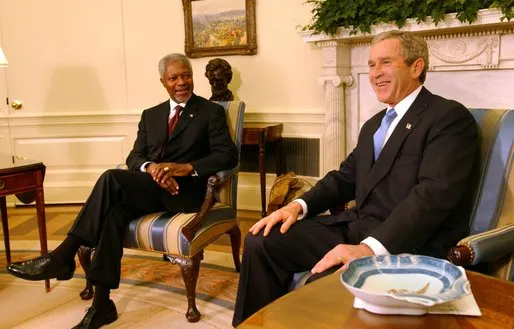
Bush Heavily Committed to the UN
Powell’s unwavering support for the United Nations and NATO closely reflected the stance of the President who appointed him. On March 23, 2001, during UN Secretary-General Kofi Annan’s visit to the White House, President George W. Bush expressed strong approval, stating, “My administration thinks he is doing an excellent job as the Secretary-General of the United Nations, and therefore, we heartily endorse his second term as Secretary-General.”35
The man President Bush praised as doing “excellent” work was, in reality, a vocal proponent of diminishing national sovereignty. In a speech to the UN General Assembly on September 18, 1999, Kofi Annan asserted, “State sovereignty, in its most basic sense, is being redefined by the forces of globalization and international cooperation.”36
In the same address, Kofi Annan described “traditional notions of sovereignty” as an “obstacle” to the United Nations’ global agenda. His stance is one of many reasons why some argue that the United States should reconsider its membership in the UN. However, rather than recognizing potential risks to U.S. sovereignty, President George W. Bush opted to praise both Annan and the organization he leads.
Annan’s predecessor, Boutros Boutros-Ghali, expressed similar views on national independence in his January 1992 document, An Agenda for Peace. He asserted, “The time of absolute and exclusive sovereignty, however, has passed; its theory was never matched by reality.”37 Remarks from other UN leaders further underscore their opposition to national sovereignty, yet U.S. officials continue to offer praise for both these figures and the United Nations itself. President George W. Bush then followed through on his commitment to pay $582 million in dues to the UN, stating in a carefully crafted announcement, “This release of funds will enhance the close bond between the United States and the United Nations…”38
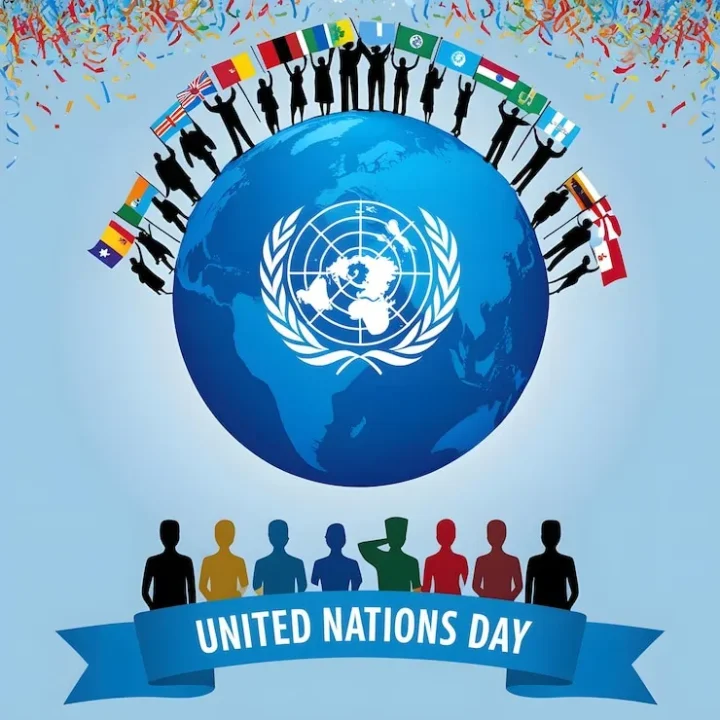
When President George W. Bush officially recognized United Nations Day on October 24, 2001, he encouraged all Americans to “pause to reflect on the noble history of the UN and to praise its many contributions toward providing a better quality of life…”39 History has repeatedly demonstrated that the United Nations’ so-called contributions have included legitimizing oppressive regimes, undermining national sovereignty, and expanding its authority over nearly every facet of global affairs.
Let me know if you’d like any refinements!
In May 2001, the United Nations removed the United States from its Human Rights Commission, replacing it with Sudan, a nation officially designated as a sponsor of terrorism by the U.S. government. Then, on January 1, 2002, Syria—another State Department-listed sponsor of terrorism—secured a seat on the UN Security Council. In August 2003, a Syrian representative even assumed the Council’s presidency. Yet, despite these developments, President George W. Bush continued to praise the UN for its “noble history.”
Following the September 11, 2001 terrorist attacks, Bush looked to both the United Nations and NATO for approval to initiate military action against Afghanistan. On September 28, 2001, the UN Security Council adopted Resolution 1373, which had been sponsored by the United States. This resolution provided official authorization for military operations targeting Afghanistan’s Taliban government and the al-Qaeda terrorist network.
On November 10, 2001, during a speech at United Nations headquarters, President George W. Bush referenced Resolution 1373, declaring, “The most basic obligations in this new conflict have already been defined by the United Nations.”40 He further declared that all nations “must pass necessary laws” to align with the mandates set forth in the UN Resolution. This allowed America’s Insiders to cite UN authority as justification for imposing sweeping domestic controls, allegedly in the name of fighting terrorism. Unsurprisingly, the Bush administration soon introduced the “necessary” legislation to ensure compliance with the very UN resolution it had championed.
When details of one particularly alarming proposal for centralizing control over all Americans emerged, New York Times columnist William Safire voiced his strong opposition:
“Every purchase you make with a credit card, every magazine subscription you buy and medical prescription you fill, every Web site you visit and e-mail you send or receive, every academic grade you receive, every bank deposit you make, every trip you book and every event you attend – all these transactions and communications will go into what the Defense Department describes as ‘a virtual, centralized grand database.’
To this computerized dossier on your private life from commercial sources, add every piece of information that government has about you -passport application, driver’s license and bridge toll records, judicial and divorce records, complaints from nosy neighbors to the FBI, your lifetime paper trail plus the latest hidden camera surveillance – and you have the supersnoop’s dream: a “Total Information Awareness” about every U.S. citizen.”41
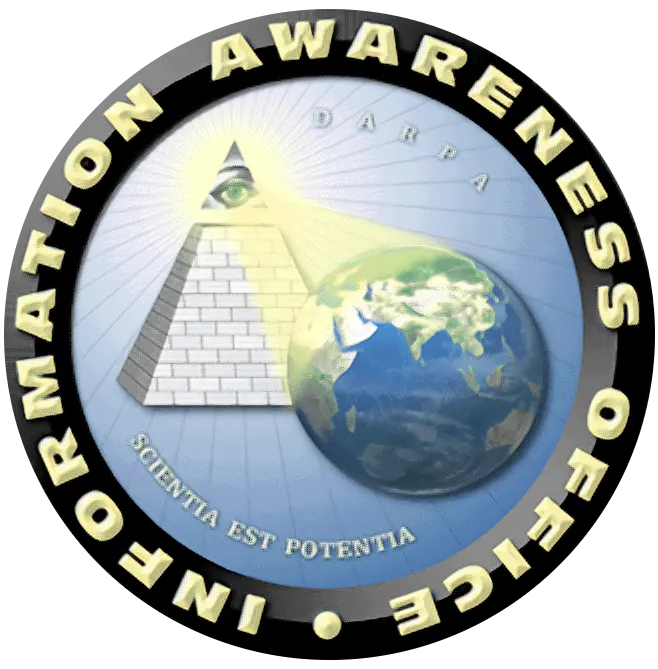
The Total Information Awareness (TIA) program, referenced by William Safire, served as the digital equivalent of the proposed Terrorism and Information Prevention System (TIPS)—a surveillance initiative that would have enlisted mail carriers, meter readers, delivery workers, and neighbors to report on the activities of ordinary citizens. This approach bore striking resemblance to Soviet-style monitoring, imposed upon a supposedly free society. Amid public outrage, Congress blocked the TIPS program, but the possibility of its revival remains.
On December 19, 2001, President George W. Bush formally announced—through a 25-page letter to the United Nations—that the United States had fulfilled its “legally binding obligations” as a UN member state. As a result, the UN now effectively dictates changes to U.S. law. This notification acknowledged the establishment of the UN’s Counter Terrorism Committee (CTC), whose directives influenced the passage of the USA Patriot Act. The act significantly expanded federal surveillance, search, and arrest powers, bypassing constitutional protections in the process.
By early 2003, the administration proposed Patriot Act II, which sought to further erode the Bill of Rights—including provisions for secret warrants against American citizens suspected of broadly defined terrorist activity.
The critical takeaway is that a UN resolution, requested by the U.S., led to the creation of the CTC, binding governments—including the United States—to initiatives that weaken individual freedoms and undermine limited government in the name of combating terrorism. The gradual transformation of America into a mere subdivision of the UN—while disregarding constitutional constraints—has long been a goal of Insiders and remains an objective of the Bush administration.
If genuine national security were the primary concern, leaders would recognize that “homeland security” cannot exist while U.S. borders remain unprotected. Given their refusal to address this fundamental issue, the motivations behind their legislative agenda remain highly suspect.
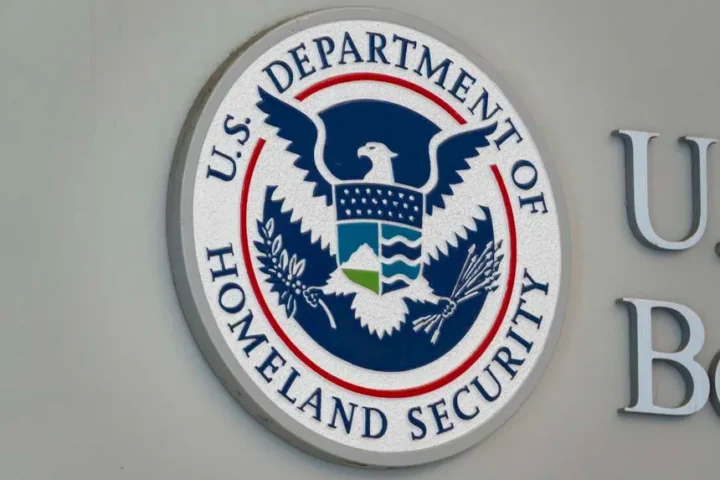
CFR’s Hand in Homeland Security
The 9/11 terrorist attacks provided an opportunity to advance long-standing Insider plans for a major shift in the federal balance of power. The foundation for this transformation had been laid by a 1998 commission, formed at the urging of President Bill Clinton and former House Speaker Newt Gingrich. Over the next three years, commission leaders Warren Rudman and Gary Hart, alongside Leslie Gelb, Lee Hamilton, and James Schlesinger, shaped the framework that ultimately became the legislation submitted to Congress. Each of these individuals was a CFR member, with Gelb serving as the organization’s president at the time.
The commission’s work, which called for the “creation of a new independent National Homeland Security Agency,” was formally presented to President George W. Bush and his Cabinet on January 31, 2001, more than seven months before 9/11. Following the attacks, these recommendations became the focus of a special meeting at the Council on Foreign Relations’ Washington office on September 14, 2001. Just six days later, Bush announced his administration’s plans to establish the Office of Homeland Security, marking the first phase of the commission’s recommendations.
Immediately after being appointed to lead this new agency, Pennsylvania Governor Tom Ridge outlined plans for “a national strategy—not a federal strategy” that would involve centralizing authority over state and local police forces while militarizing law enforcement functions—practices commonly associated with totalitarian states. These ideas, rejected by America’s Founders, had never been seriously considered in U.S. history.
Throughout history, national police forces, such as those in Nazi Germany and Soviet Russia, have served the government rather than the people. Today, similar forces continue to operate in Communist-controlled China, Cuba, and North Korea. Their purpose is not to protect citizens but rather to secure the regime from potential opposition. By contrast, local police forces exist to protect the people and safeguard individual liberties, and the distinction between the two cannot be overstated.
By 2002, Congress formally elevated the Department of Homeland Security to cabinet-level status, consolidating vast power and personnel under a single federal entity.
President Bush had previously stated that the “most basic obligations” he sought to fulfill had been “defined by the United Nations.” A more candid assessment would have revealed that these obligations had been “defined” by the Council on Foreign Relations.
Following the European Union Model
Undermining national sovereignty has long remained a central objective of Insider influence. Through military, political, and economic entanglements, they employ various strategies to achieve this aim. Policies successfully implemented elsewhere inevitably find their way into the United States.
Over the past few decades, European nations—once independent—have gradually become subsumed within the European Union. Many citizens, initially persuaded that economic integration would bring prosperity through eased trade and travel, later realized that this was merely the first step toward political union and the erosion of sovereignty. From the outset, those advocating financial advantages were actually pursuing a broader vision: global governance.
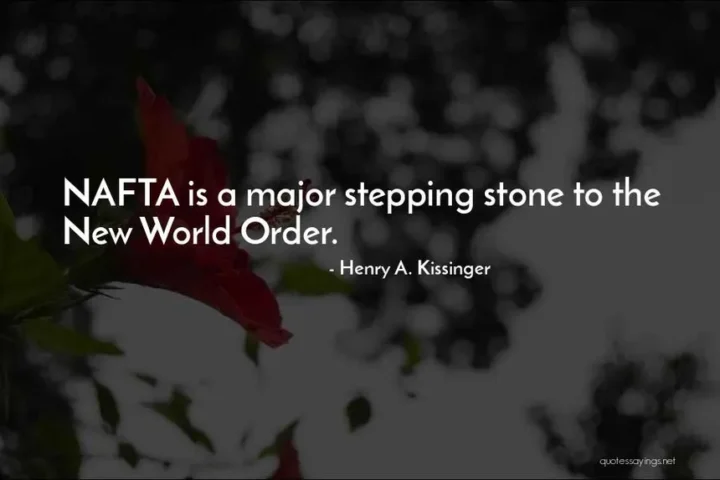
Now, the same approach that transformed Europe is being championed by Insiders within the United States, with President George W. Bush playing a leading role. Americans should have recognized the warning signs a decade earlier, when President Bill Clinton and Council on Foreign Relations (CFR) member Henry Kissinger enthusiastically pushed for U.S. approval of the North American Free Trade Agreement (NAFTA).
Kissinger made no effort to obscure the pact’s deeper implications, stating, “It will represent the most creative step toward a new world order taken by any group of countries since the end of the Cold War… not a conventional trade agreement but the architecture of a new international system.”42
As opponents had warned, NAFTA swiftly led to changes in U.S. law. For instance, regulations limiting the number of Mexican trucks entering the country and requiring cargo inspections faced opposition from Mexican authorities, who cited NAFTA provisions. Because the U.S. had committed to the agreement, policymakers adjusted domestic laws accordingly, compromising national sovereignty in the process.
On January 8, 1998, the Dallas Morning News reported that uninspected Mexican trucks had contributed to a surge in heroin trafficking within the United States. Additional NAFTA-imposed policies followed. In November 2003, the House Committee on Education and the Workforce referenced a study from the Economic Policy Institute, which documented the loss of nearly 900,000 American jobs due to NAFTA.43
Likewise, when President Bill Clinton (CFR) and Newt Gingrich (CFR) pushed for Congress to approve U.S. membership in the World Trade Organization (WTO), another clear threat to national sovereignty should have been recognized. Gingrich himself acknowledged the magnitude of this shift, stating that joining the WTO represented “a big transfer of power … a transformational moment.”44
Likewise, when President Bill Clinton (CFR) and Newt Gingrich (CFR) advocated for Congress to approve U.S. membership in the World Trade Organization (WTO), another assault on national sovereignty should have been evident. Gingrich himself acknowledged the significance of this move, calling it “a big transfer of power … a transformational moment.”45
Much like NAFTA, it didn’t take long for the Geneva-based World Trade Organization (WTO) to pressure the United States into altering its tax policies, leveraging the threat of sanctions and fines to enforce compliance.46
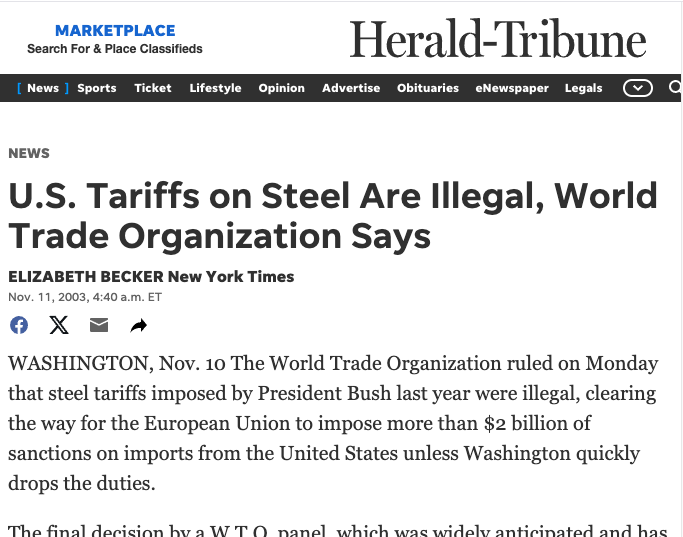
Fines are concerning enough, but WTO-imposed sanctions could force member nations to enact boycotts against any country targeted for noncompliance. Congressman Ron Paul (R-Texas) argued that the true consequence of WTO membership is not its supposed trade advantages, but rather its impact on national sovereignty. He firmly stated, “We should never deliver to any international governing body the authority to dictate what our laws should be.”47 But the attack on U.S. sovereignty continued when WTO ruled in March 2003 that U.S. steel tariffs are illegal.
In 1993, while advocating for Congress to approve NAFTA, Council on Foreign Relations (CFR) heavyweight Henry Kissinger envisioned a Western Hemisphere-wide free trade system, describing NAFTA as merely “the first step” toward that larger objective.47 Nearly a decade later, President George W. Bush actively promoted the establishment of the Free Trade Area of the Americas (FTAA)—another milestone in the Insider agenda. If implemented, the FTAA would subject all Western Hemisphere nations—including the United States—to the same erosion of sovereignty that the European Union, NAFTA, and WTO had already inflicted upon their respective member states.
The FTAA plan calls for all Western Hemisphere nations to submit to its regulations, which would harmonize policies across business, industry, labor, agriculture, transportation, immigration, education, taxation, environment, health, trade, defense, criminal justice, and more—stretching “from Alaska to Tierra del Fuego” at the southern tip of South America.
This agreement marks the beginning of a regional government, initially focused on trade, but gradually expanding its control into other areas of national governance. Over time, an independent United States, once fully sovereign over its own destiny, would cease to exist.
Similar developments have already taken place in Europe, where integration efforts have resulted in open borders, a single currency managed by a central authority, increased taxation, and a host of other consequences. Now, European nations are being pressured to adopt a new constitution, consolidating even more centralized power in Brussels at the expense of individual state independence.
At the April 2001 Quebec summit, attended by heads of state from 34 Western Hemisphere nations, President George W. Bush endorsed the “Declaration of Quebec City,” which contained the following statement:
“We direct our Ministers to ensure that negotiations of the FTAA Agreement are concluded no later than January 2005 and to seek its entry into force as soon as possible thereafter, but in any case, no later than December 2005.”
In his January 16, 2002 address to the National Conference of the World Affairs Councils—a gathering aligned with Insider interests—President George W. Bush reaffirmed his commitment to their agenda, declaring, “We’re working to build a Free Trade Area of the Americas, and we’re determined to complete those negotiations by January of 2005.”49 The push to dismantle national sovereignty and establish global governance continues, masked by reassuring language about the supposed advantages of trade.
After Vice President Dick Cheney addressed the Council on Foreign Relations (CFR) on February 15, 2002, David Rockefeller, a former CFR and Trilateral Commission Chairman, seized the moment to deliver his own remarks. Expressing strong enthusiasm, Rockefeller praised Cheney’s “endorsement for the free trade agreement for all the Americas”, noting that the issue had been “a great concern to me for many years, and particularly recently.”50
Whatever David wants, Insiders and Insider wannabes also want.
Clinton to Bush: Hardly Skipping a Beat
Insiders understand that a global government cannot be realized without the merging of all nations. They also recognize that such integration would be unlikely as long as the U.S. and China remain adversaries. From their perspective, China must be assimilated into the international framework—a process that has long been facilitated by American leaders granting legitimacy to Beijing’s ruling regime.
China will not be pressured to change politically, as it is already a totalitarian state. Instead, it merely requires economic strengthening to become “mergeable” into a larger global system. The United States, on the other hand, must undergo a transformation—from a constitutionally limited government to a highly centralized authority that aligns more easily with the coming world government.
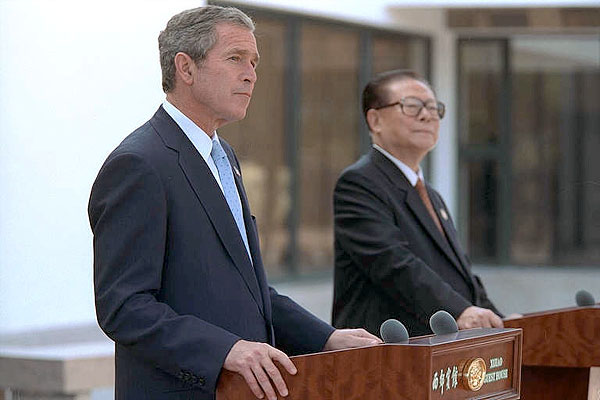
Following in Bill Clinton’s footsteps, President George W. Bush traveled to China in October 2001, then returned in February 2002 to further engage with Chinese leadership. During his visit, he remained silent as President Jiang Zemin declared that China “provided for the freedom of religious belief” and that “the religious faiths of all Chinese are protected by our Constitution.” A stronger leader would have challenged such blatant falsehoods or even walked away in protest.
Meanwhile, credible reports continued to emerge detailing China’s persecution of Catholic, Protestant, and Falun Gong practitioners, alongside numerous other human rights abuses.
While still in China, President George W. Bush expressed enthusiasm for the Beijing government’s “cooperation in our war against terrorism.” 51 even though China has supplied weaponry both to Afghanistan’s Taliban regime and Osama bin Laden’s al-Qaeda terrorists. China is also a chief exporter of missile technology to tyrannical regimes in North Korea and Iran, both named along with Iraq by the President himself as members of an “axis of evil.”
While escalating the U.S.-led, UN-authorized campaign against Iraq, President George W. Bush hosted Chinese leader Jiang Zemin at his Texas ranch for a barbecue. At the time, Iraq was being vilified over suspicions that Saddam Hussein’s regime might possess nuclear weapons, might have aided the 9/11 attackers, had a poor human rights record, and had engaged in aggression against neighboring nations.
Yet China, which not only has nuclear weapons but whose leaders had openly stated their willingness to use them against U.S. cities should Washington interfere with Beijing’s plans for Taiwan, was treated as an ally. China had also supplied military aid to Afghanistan’s Taliban regime, which harbored the terrorists responsible for 9/11, and maintained a human rights record rife with forced abortions, infanticide, euthanasia policies, and suppression of religious freedoms. Its decades-long occupation of Tibet sought to erase the region’s cultural identity entirely.
Despite these facts, Bush continued to paint Iraq as the ultimate threat while embracing China as a partner, mirroring Bill Clinton’s similar approach to Chinese leadership.
Bush’s selective focus on Iraq while overlooking China’s actions stemmed largely from his alignment with Insider interests and the UN’s agenda. While the UN routinely avoided condemning China, it had issued more than a dozen resolutions targeting Iraq. Following this framework, Bush asked Congress for authorization to use U.S. military force to carry out the UN’s anti-Iraq campaign. In his September 26, 2002 address to Congress, he asserted that approving his request would “send a clear message to the world and to the Iraqi regime: The demands of the UN Security Council must be followed.”52 By ceding its sole constitutional authority over war declarations, Congress authorized the president to “use the Armed Forces of the United States as he determines to be necessary and appropriate”—not only to defend national security against Iraq’s alleged threat but also to “enforce all relevant United Nations Security Council resolutions regarding Iraq.”
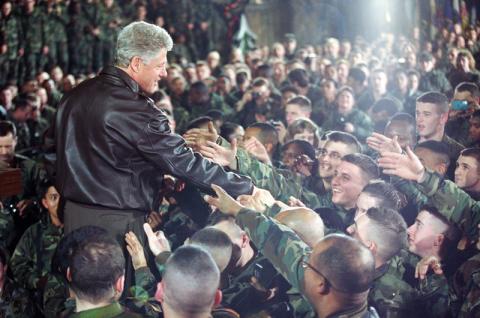
Previously, Bill Clinton had relied on UN authorization to deploy American forces across various global conflict zones, circumventing constitutional constraints whenever they proved inconvenient. In addition, he burdened the nation with economic agreements that eroded U.S. sovereignty. Now, President George W. Bush was following a similar path.
The Insider-controlled media’s portrayal of Bush as a conservative served as a false veneer, masking his big-government, debt-fueled policies—both foreign and domestic—which aligned with Insider priorities. This misrepresentation also neutralized opposition, diminishing scrutiny from those who might otherwise reject unconstitutional expansions of power.
Clear parallels to Clinton’s actions were evident for those willing to look beyond media narratives. Even the arch-liberal Washington Post noted that inflation-adjusted spending had increased 9% during Clinton’s last two years, whereas it was set to rise nearly 15% during Bush’s first two years.53 This estimate, of course, appeared before the huge outlays needed for the Iraq War could be taken into account.
Chris Edwards of Liberty magazine offered another criticism of the Bush budget, noting that while it “includes tough talk about federal programs that don’t work,” it continues to expand funding for them. He remarked, “Health and Human Services … Amtrak … farm subsidies … the Department of Education—is there any bloated, ill-performing, useless, destructive, or unconstitutional federal program whose budget George W. Bush isn’t trying to increase?”54 But Americans continue to hear the President described as “a strong conservative.”
After signing a bill that significantly expanded Department of Education funding, President George W. Bush publicly praised its Senate sponsor, Ted Kennedy of Massachusetts, at a joint appearance in Boston. Bush enthusiastically remarked, “Mr. Senator, not only are you a good senator, you’re a good man.”
Kennedy—who had consistently supported Bill Clinton’s proposals—responded by cheerfully assuring the Boston audience of “the difference it has made” having George Bush in the White House.55 Can anyone still insist that George W. Bush is a “conservative”? Clearly, Ted Kennedy doesn’t think so.
Several of George W. Bush’s policies have led many to question whether Bill Clinton ever left office, as they closely mirror Clinton-era initiatives. These include increased funding for the National Endowment for the Arts, expanded foreign aid, rejection of an abortion “litmus test” for Supreme Court nominees, and continued federal land acquisitions—with no reversal of Clinton’s designation of vast areas as federal preserves and parks.
Additional parallels include subsidies for pro-abortion and sodomite initiatives at home and abroad, framed as part of the global fight against AIDS, along with a multi-million-dollar bailout for the UN’s International Monetary Fund, support for extending Clinton’s ban on semi-automatic weapons, and advancing campaign finance reform legislation that restricts free speech—despite earlier pledges to oppose such measures.

The Bush administration also maintained Clinton’s approach to engaging with sodomite advocacy groups. Shortly after taking office, Attorney General John Ashcroft met with leaders of the Log Cabin Republicans, a national sodomite organization, on February 22, 2001. During their discussion, Ashcroft warmly welcomed the group’s leaders, assuring them that he would seek their input on matters of importance to sodomites.56 The President has declined to revoke the military’s recognition of sodomites in the military, maintaining the policy as it stands.
In 1966, historian Carroll Quigley remarked that “the two parties should be almost identical” to allow government by an elitist ‘secret society’ to continue uninterrupted—a pattern that has certainly played out over the past several decades.
The Final Power Grabs
In the first edition of The Insiders (John F. McManus, The John Birch Society, 1979), Mr. McManus supplied hard truths about Insider Domination of our nation’s government and major institutions. At that time, few Americans were aware that such a clandestine group even existed, let alone that its agenda was actively being carried out. Fortunately, today, many more citizens recognize that limited government—”of the people, by the people, and for the people”—has been deliberately undermined by a network of Insiders committed to dismantling freedom and constructing a centralized global authority.
While this progress is encouraging, it is far from sufficient to halt the Insiders’ agenda and restore control over our government. Much greater awareness must be fostered, and time is quickly running out to take meaningful action.
The administration of George W. Bush—largely steered by Dick Cheney, Donald Rumsfeld, and other Insider veterans—has been portrayed as the embodiment of “conservatism.” Yet, Bush, like the wolves in sheep’s clothing of today, benefits greatly from the misappropriation of this term and its former clarity.
Government deceivers and mass media narratives have strategically attached the “conservative” label to un-American internationalism and expansive government socialism, distorting its original meaning.
The guiding standard for Americans must never be a vague, undefined, or ever-changing “conservatism.” Instead, it must be the Constitution—the very foundation to which all government officials solemnly pledge their adherence.
Had the Constitution been upheld as intended, the harm inflicted upon our nation, as detailed in these pages, would never have come to pass.
Among only two organizations formed to combat the Insider’s control of our nation and the drive to deliver America to global government, the Tree of Liberty Society and it’s campaign to:
Build Understanding what has built free nations.
Expose and legitimize this conspiracy seeking to destroy the liberty of all mankind.
Build an effective resistance to that conspiracy.
If successful, will annihilate the conspiracies network built by these evil individuals called “Insiders”.
If you cherish freedom—for yourself and your loved ones—reach out to the Tree of Liberty Society to explore its unique mission. Understanding the Society’s work reveals a powerful path to safeguarding the American dream and ushering in a new era of liberty under principled, godly government.
Is Trump another Reagan and Bush? Subscribe to our email or text alerts to be notified when our next report on wolves in sheep’s clothing is released.
Notes
1. Carroll Quigley, Tragedy and Hope (New York: The Macmillan Company, 1966) p. 131.
2. Ibid., pp. 132, 950.
3. Ibid., pp.124 7-48.
4. Ibid., p. 1248.
5. Ibid., p. 1248.
6. Arnold Beichman, “Interview With Condi,” • Washington Times, July 21, 1999; “Bush’s brain trust,” Washington Times, March 28, 1999; Time magazine, June 21, 1999.
7. James J. Drummey, “George Shultz: The Rhetoric and the Record,” The New American, May 19, 1986, pp. 27-34.
8. Beichman, op. cit.
9. Eric Schmitt, “A Cadre of Familiar Foreign Policy Experts Is Putting Its Imprint on Bush,” New York Times, December 23, 1999.
10. John M. Broder, “A Gore Team Poised to Direct Foreign Policy,” New York Times, May 17, 2000.
11. James M. Lindsay, “The New Apathy,” Foreign Affairs, September/October 2000, p. 8.
12. “Lone-Star Conservatism,” The New American, July 20, 1998, pp. 6-7, citing a report appearing in the Houston Chronicle.
13. Ibid.
14. Barbara Slavin and Susan Page, “Cheney is power hitter in White House lineup,” USA TODAY, July 28, 2002.
15. Elizabeth Bumiller and Eric Schmitt, “Cheney Forges Powerful Bond With Bush,” New York Times, January 31, 2003.
16. Speech broadcast by C-SPAN, February 15, 2002.
17. Lawrence F. Kaplan, “From Russia With Loans,” The New Republic, August 7, 2000.
18. Neil Mackay, “Bush planned Iraq regime change before becoming President,” London Sunday Herald, internet posting, October 4, 2002; Todd S. Purdum, “The Brains Behind Bush’s War,” New
York Times, January 31, 2003.
19. Article authored by Philip Kerr, Foreign Affairs, September 1922.
20. “Freedom From War: The United States Program for General and Complete Disarmament in a Peaceful World” (also known as Department of State Publication 7277), September 1961.
21. Lincoln P. Bloomfield, “A World Effectively Controlled by the United Nations,” Washington, D.C., Institute for Defense Analyses, March 10, 1962.
22. Congressional Record, July 18, 1949, pp. 9111- 9113.
23. The North Atlantic Treaty, August 24, 1949.
24. The SEATO Treaty contains some of the exact language appearing in the NATO Treaty. And the Congressional Record for July 14, 1966 (page 14953) published a statement from the American
Bar Association noting that “the SEATO regional defense agreement is firmly rooted in Article 51 of the United Nations Charter.”
25. U.S. News & World Report, January 7, 1991.
26. Presidential Statement issued by the White House, February 6, 2003.
27. {JN Security Council Resolution 1373, September 28, 2001.
28. “USUN Press Release #38 (03),” March 21, 2003.
29. Annual Report 1992, Council on Foreign Relations, New York.
30. Annual Report 2000, Council on Foreign Relations, New York.
31. Annual Report 2002, Council on Foreign Relations, New York.
32. State Department release, January 17, 2001.
33. Jane Perlez, “Powell Takes Populist Tack On First Day At State Department,” New York Times, January 23, 2001.
34. John Diamond, “Powell Softens Rhetoric of Bush Campaign,” Chicago Tribune, February 15, 2001.
35. Gary Benoit, “Mr. Bush’s Kind of SecretaryGeneral,” The New American, April 23, 2001, p .44.
36. Kofi Annan speech, “Two concepts of sovereignty,” United Nations release, September 18, 1999.
37. Boutros Boutros-Ghali, An Agenda For Peace, United Nations Department of Public Information, New York, 1992.
38. White House release, October 5, 2001.
39. Presidential Documents, Federal Register, October 30, 2001.
40. Text published, New York Times, November 11, 2001.
41. William Safire, “You Are a Suspect,” New York Times, November 14, 2002.
42. Henry Kissinger, “With NAFTA, U.S. Finally Creates a New World Order,” Los Angeles Times, July 18, 1993.
43. Rep. George Miller, Senior Democratic Member, House Committee on Education and the Workforce, “Dear Colleague” letter, November 28, 2003.
44. “Why Has Gingrich Shifted on WTO?”, Human Events, August 5, 1994.
45. Paul Meller, “Europeans Seek $4 Billion in Trade Sanctions Against U.S.,” New York Times , November 18, 2000.
46. Interview of Rep. Ron Paul, The New American, April 24, 2000.
47. Kissinger, op.cit.
48. White House release, January 16, 2002.
49. C-SPAN Broadcast, op.cit.
50. White House release, February 21, 2002.
51. White House release, September 26, 2002.
52. Glenn Kessler, “2003 Budget Completes Big Jump in Spending,” Washington Post, April 15, 2002.
53. Chris Edwards, “Good Rhetoric, Bad Budget,” Liberty, April 2002.
54. Anne E. Kornblut, “School ties for Bush and Kennedy,” Boston Globe, January 9, 2002.
55. Lou Chibbaro, “Ashcroft hosts Log Cabin,” Washington Blade, February 23, 2002.
56. William Norman Grigg, Global Gun Grab: The United Nations Campaign to Disarm Americans,” (Appleton, Wis.: The John Birch Society, 2001.)

